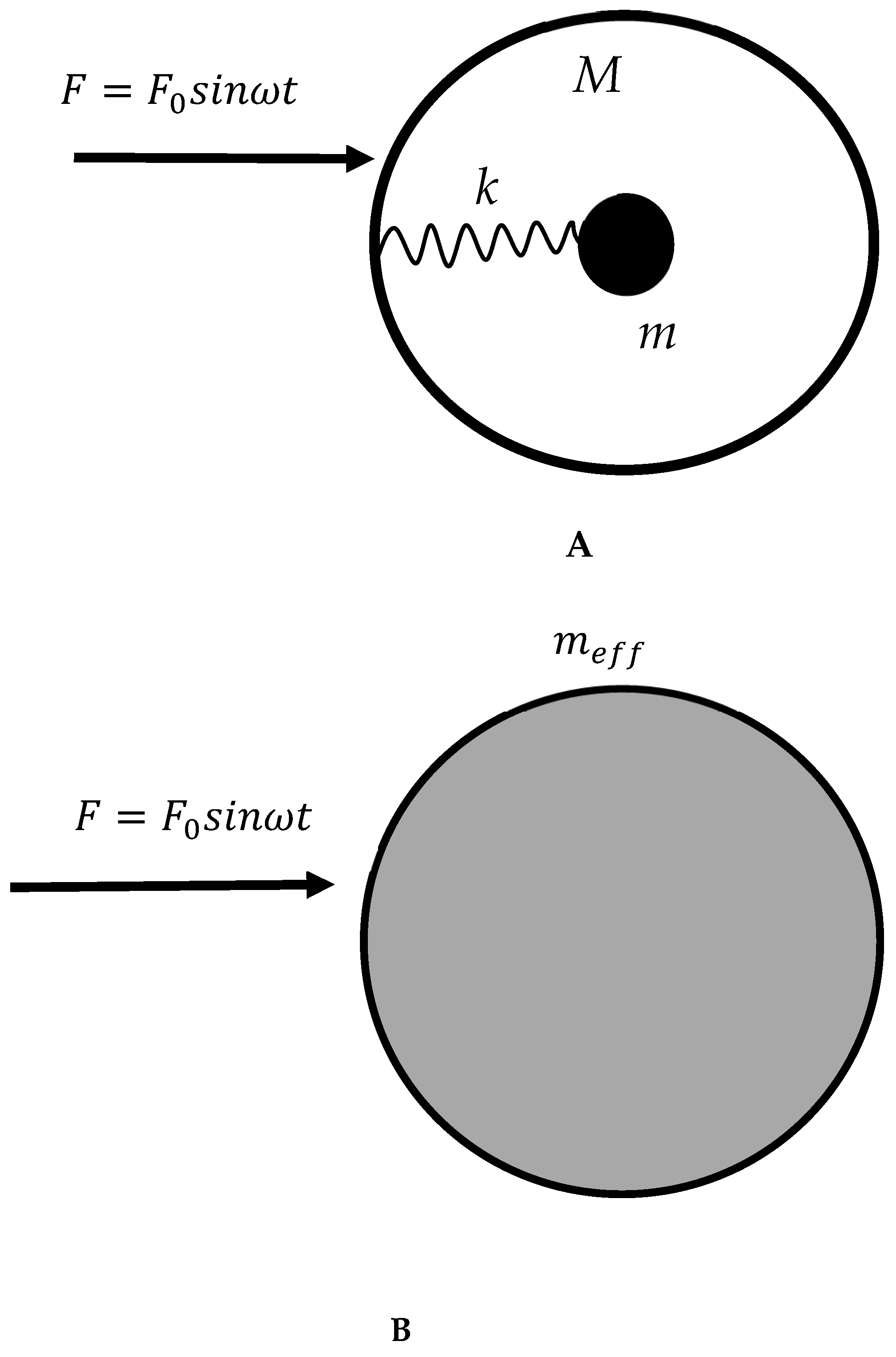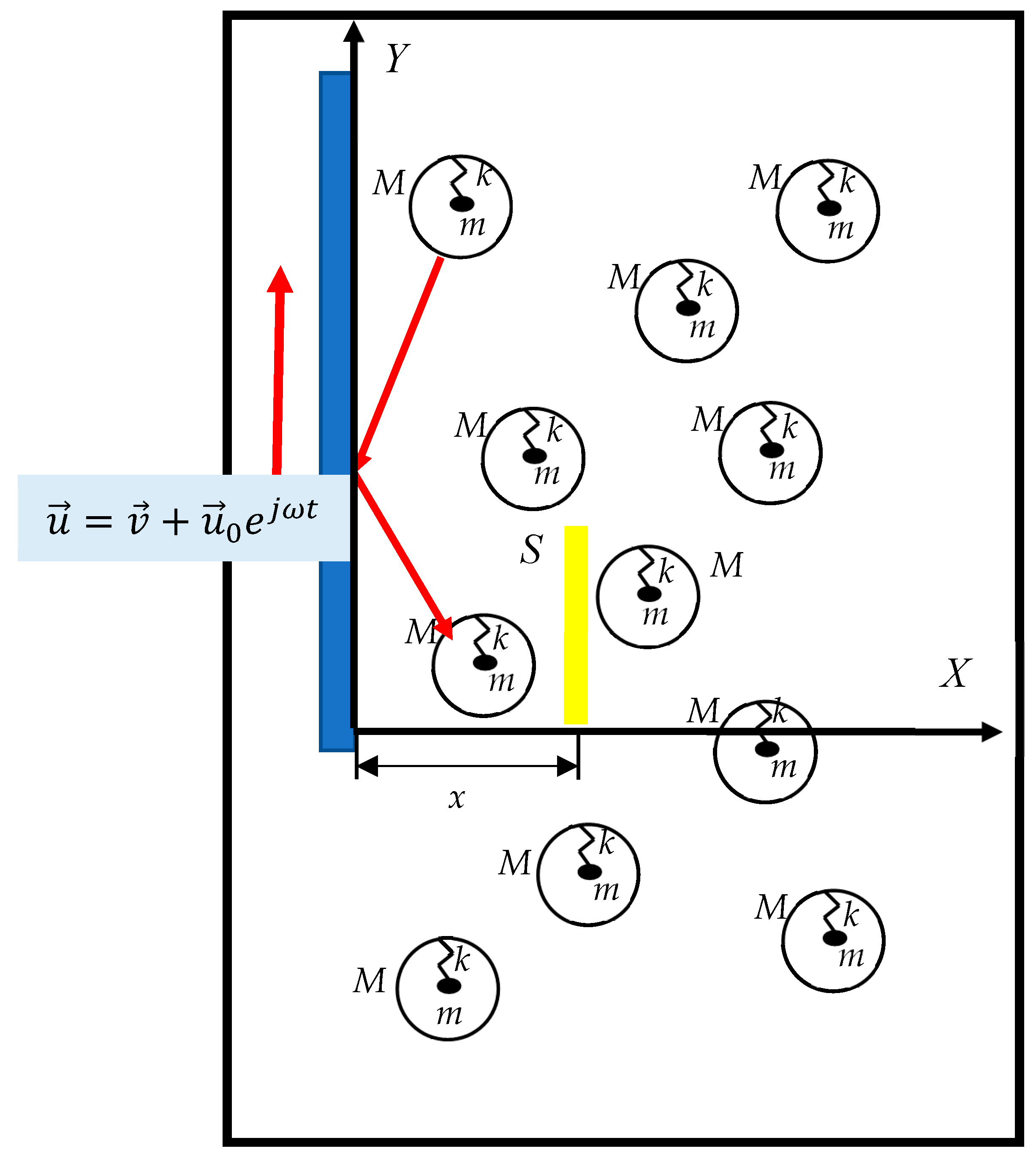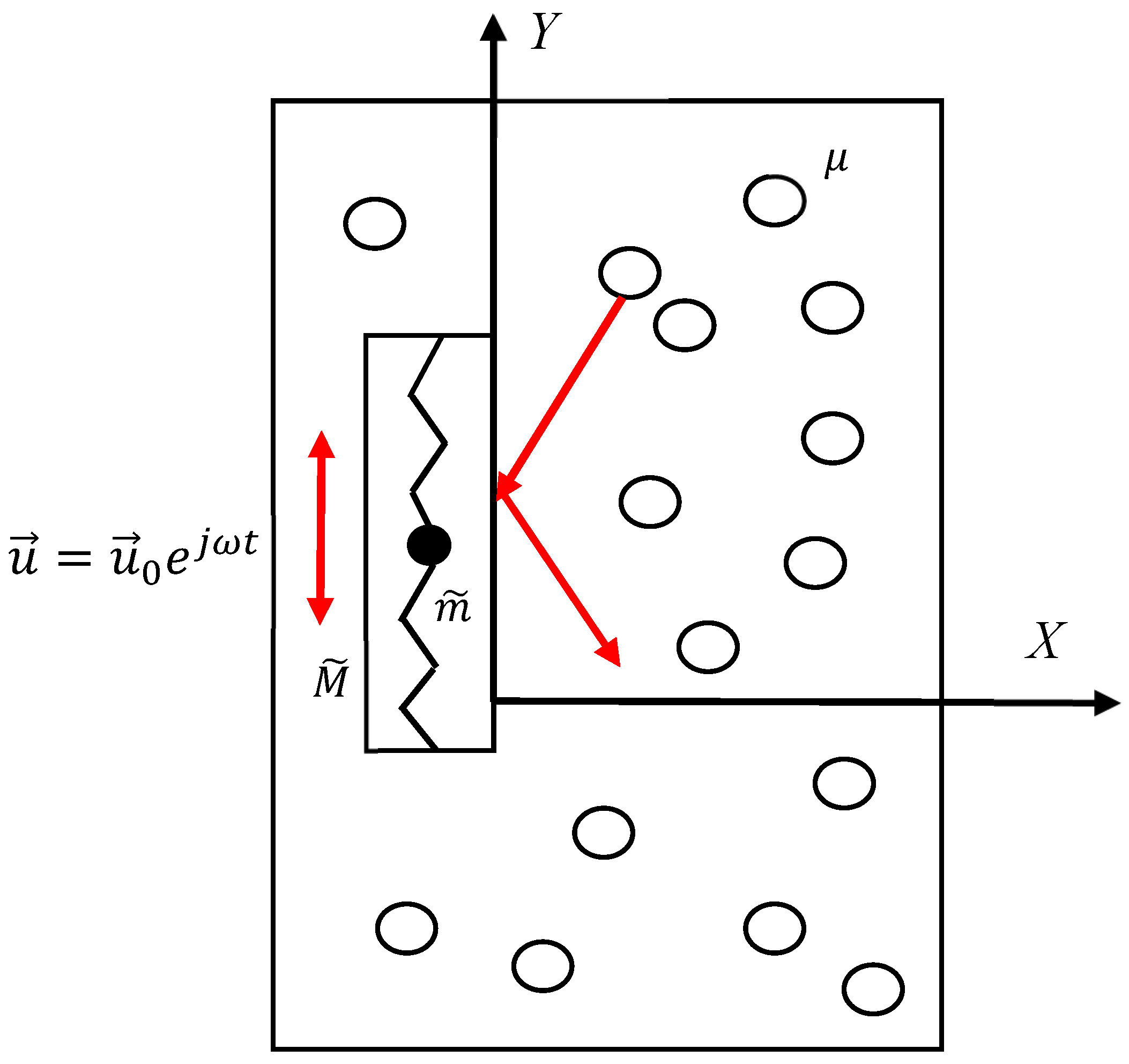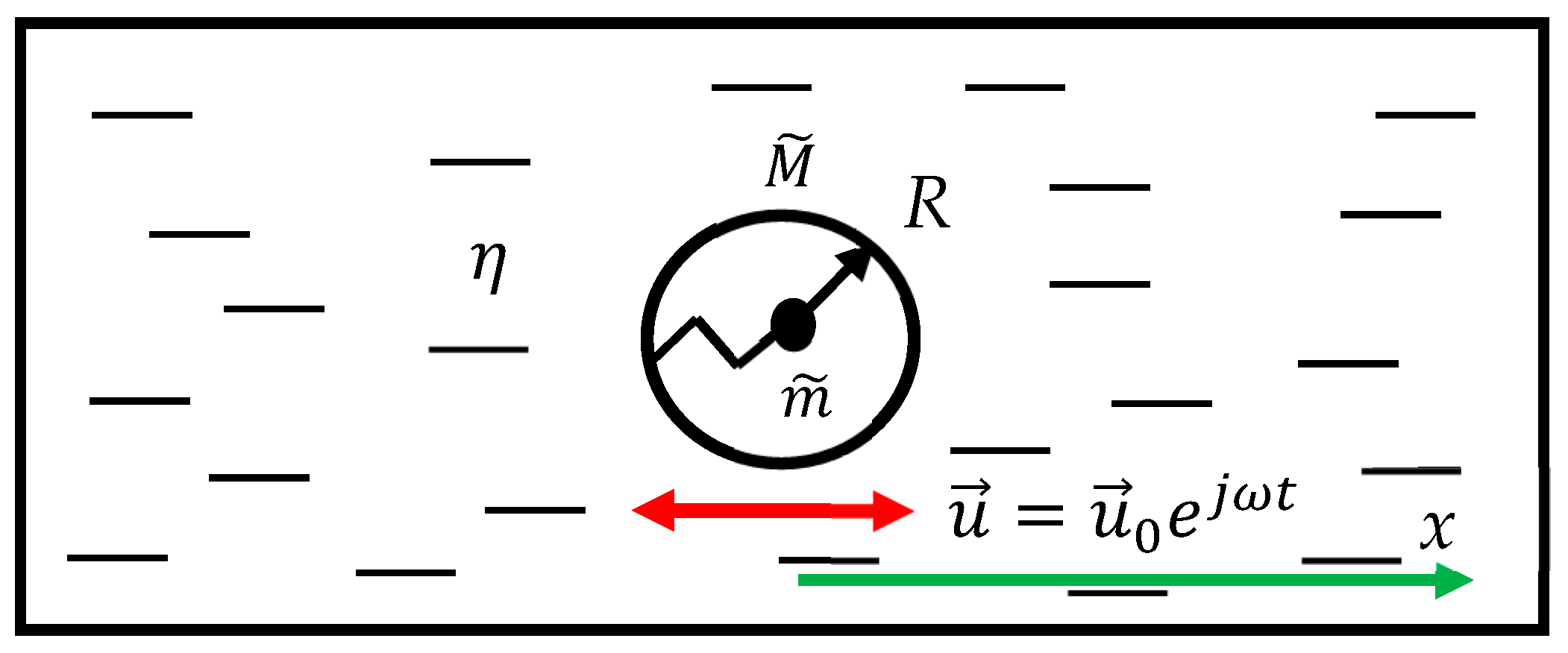Negative-Viscosity Materials: Exploiting the Effect of Negative Mass
Abstract
1. Introduction
2. Results
3. Discussion
- (i)
- Introducing of gaseous medium, demonstrating negative viscosity and exploiting resonant core–shell systems;
- (ii)
- Introducing liquid media, demonstrating negative effective viscosity and exploiting the resonant negative effective mass of the vibrated body moving through the liquid.
4. Conclusions
Author Contributions
Funding
Institutional Review Board Statement
Informed Consent Statement
Data Availability Statement
Conflicts of Interest
References
- Veselago, V.G. The electrodynamics of substances with simultaneously negative values of e and u. Sov. Phys. Uspekhi 1968, 10, 509–514. [Google Scholar] [CrossRef]
- Cui, T.J.; Smith, D.; Liu, R. Metamaterials. Theory, Design, and Applications; Springer: New York, NY, USA, 2010. [Google Scholar]
- Jiao, P.; Mueller, J.; Raney, J.R.; Zheng, X.; Alavi, A.H. Mechanical metamaterials and beyond. Nat. Commun. 2023, 14, 6004. [Google Scholar] [CrossRef]
- Yang, F.; Zhang, Z.; Xu, L.; Liu, Z.; Jin, P.; Zhuang, P.; Lei, M.; Liu, J.; Jiang, J.-H. Controlling mass and energy diffusion with metamaterials. Rev. Mod. Phys. 2024, 96, 015002. [Google Scholar] [CrossRef]
- Singh, A.K.; Abegaonkar, M.P.; Koul, S.K. Metamaterials for Antenna Applications; CRC Press: Boca Raton, FL, USA, 2022. [Google Scholar]
- Felbacq, D.; Bouchitté, G. Metamaterials Modelling and Design; Taylor & Francis, Pan Stanford Publishing: Singapore, 2017. [Google Scholar]
- Marques, R.; Martin, F.; Sorolla, M. Metamaterials with Negative Parameters: Theory, Design, and Microwave Applications; Wiley Series in Microwave and Optical Engineering Book 183; John Wiley & Sons: Hoboken, NJ, USA, 2008. [Google Scholar]
- Engheta, N.; Ziolkowski, R.W. Electromagnetic Metamaterials: Physics and Engineering Explorations; IEEE Press: Hoes Lane, NJ, USA, 2006. [Google Scholar]
- Semouchkina, E. Dielectric Metamaterials and Metasurfaces in Transformation Optics and Photonics; Woodhead Publishing: Cambridge, MA, USA, 2021. [Google Scholar]
- Cai, W.; Shalaev, V. Optical Metamaterials. Fundamentals and Applications; Chapter 5; Springer: New York, NY, USA, 2010. [Google Scholar]
- Wu, W.; Hu, W.; Qian, G.; Liao, H.; Xu, H.; Berto, F. Mechanical design and multifunctional applications of chiral mechanical metamaterials: A review. Mater. Des. 2019, 180, 107950. [Google Scholar] [CrossRef]
- Kshetrimayum, R.S. A Brief Intro to Metamaterials. IEEE Potentials 2004, 23, 44–46. [Google Scholar] [CrossRef]
- Bormashenko, E. Bioinspired Materials and Metamaterials; CRC Press: Boca Raton, FL, USA, 2025. [Google Scholar]
- Li, Y.; Li, W.; Han, T.; Fan, S.; Qui, S.-W. Transforming heat transfer with thermal metamaterials and devices. Nat. Rev. Mater. 2021, 6, 488–507. [Google Scholar] [CrossRef]
- Milton, G.W.; Willis, J.R. On modifications of Newton’s second law and linear continuum elastodynamics. Proc. R. Soc. A 2007, 463, 855–880. [Google Scholar] [CrossRef]
- Liu, X.N.; Hu, G.K.; Huang, G.L.; Sun, C.T. An elastic metamaterial with simultaneously negative mass density and bulk modulus. Appl. Phys. Lett. 2011, 98, 251907. [Google Scholar] [CrossRef]
- Rodrigues, I.C.; Steele, G.A.; Bothner, D. Photon Pressure with an Effective Negative Mass Microwave Mode. Phys. Rev. Lett. 2024, 132, 203603. [Google Scholar] [CrossRef]
- Chan, C.T.; Li, J.; Fung, K.H. On extending the concept of double negativity to acoustic waves. JZUS A 2006, 7, 24–28. [Google Scholar] [CrossRef]
- Huang, H.H.; Sun, C.T.; Huang, G.L. On the negative effective mass density in acoustic metamaterials. Int. J. Eng. Sci. 2009, 47, 610–617. [Google Scholar] [CrossRef]
- Bhatt, A.; Banerjee, A. Double attenuation peaks in metamaterial with simultaneous negative mass and stiffness. Phys. Lett. A 2022, 443, 128201. [Google Scholar] [CrossRef]
- Bormashenko, E.; Legchenkova, I. Negative effective mass in plasmonic systems. Materials 2020, 13, 1890. [Google Scholar] [CrossRef] [PubMed]
- Bormashenko, E.; Legchenkova, I.; Frenkel, M. Negative Effective Mass in Plasmonic Systems II: Elucidating the Optical and Acoustical Branches of Vibrations and the Possibility of Anti-Resonance Propagation. Materials 2020, 13, 3512. [Google Scholar] [CrossRef]
- Golovkin, B.G. High temperature negative mass plasma. Ann. Math. Phys. 2024, 7, 118–137. [Google Scholar]
- Liu, Z.Y.; Zhang, X.X.; Mao, Y.W.; Zhu, Y.Y.; Yang, Z.Y.; Chan, C.N.; Sheng, P. Locally resonant sonic materials. Science 2000, 289, 1734–1736. [Google Scholar] [CrossRef]
- Lončar, J.; Igrec, B.; Babić, D. Negative-inertia converters: Devices manifesting negative mass and negative moment of inertia. Symmetry 2022, 14, 529. [Google Scholar] [CrossRef]
- Peralta, I.; Fachinotti, V.D.; Álvarez Hostos, J.C. A Brief Review on Thermal Metamaterials for Cloaking and Heat Flux Manipulation. Adv. Eng. Mater. 2020, 22, 1901034. [Google Scholar] [CrossRef]
- Liu, J.; Deng, J.; Chen, D.; Huang, Q.; Pan, G. Design and performance of ultra-broadband composite meta-absorber in the 200 Hz–20 kHz range. J. Sound Vib. 2024, 574, 118229. [Google Scholar]
- Liao, G.; Luan, C.; Wang, Z.; Liu, J.; Yao, X.; Fu, J. Acoustic Metamaterials: A Review of Theories, Structures, Fabrication Approaches, and Applications. Adv. Mater. Technol. 2021, 6, 2000787. [Google Scholar] [CrossRef]
- Lim, C.W. From Photonic Crystals to Seismic Metamaterials: A Review via Phononic Crystals and Acoustic Metamaterials. Arch. Comput. Methods Eng. 2022, 29, 1137–1198. [Google Scholar]
- Bacri, J.-C.; Perzynski, R.; Shliomis, M.I.; Burde, G.I. “Negative-Viscosity” Effect in a Magnetic Fluid. Phys. Rev. Lett. 1995, 75, 2128. [Google Scholar] [CrossRef] [PubMed]
- Shliomis, M.I.; Morozov, K.I. Negative viscosity of ferrofluid under alternating magnetic field. Phys. Fluids 1994, 6, 2855–2861. [Google Scholar] [CrossRef]
- Li, W.; Li, Z.; Han, W.; Li, Y.; Yan, S.; Zhao, Q.; Chen, F. Measured viscosity characteristics of Fe3O4 ferrofluid in magnetic and thermal fields. Phys. Fluids 2023, 35, 012002. [Google Scholar] [CrossRef]
- Paras, R.; Anupam, B. Negative viscosity effects on ferrofluid flow due to a rotating disk. Int. J. Appl. Electromagn. Mech. 2013, 41, 467–478. [Google Scholar]
- Sivashinsky, G.; Yakhot, V. Negative viscosity effect in large-scale flows. Phys. Fluids 1985, 28, 1040–1042. [Google Scholar] [CrossRef]
- Malkin, A.Y. Rheology Fundamentals; ChemTec Publ.: Toronto, ON, Canada, 1994. [Google Scholar]
- Macosco, C.W. Rheology Principles; Wiley-VCH: Weinheim, Germany, 1994. [Google Scholar]
- Dong, X.; Dykman, M.I.; Chan, H.B. Strong negative nonlinear friction from induced two-phonon processes in vibrational systems. Nat. Commun. 2018, 9, 3241. [Google Scholar] [CrossRef]
- Ferri, A.A.; Whiteman, W.E. Free response of a system with negative viscous damping and displacement-dependent dry friction damping. J. Sound Vib. 2007, 306, 400–418. [Google Scholar] [CrossRef]
- Yan, H.; Liu, C.-L.; Zhang, L.; Bai, X.; Zhang, F. Effects of viscosity and density on film cooling effectiveness of turbine blade with pressure gradient and surface curvature. Int. J. Therm. Sci. 2023, 193, 108517. [Google Scholar] [CrossRef]
- Favuzzi, I.; Carenza, L.; Corberi, F.; Gonnella, G.; Lamura, A.; Negro, G. Rheology of active emulsions with negative effective viscosity. Soft Mater. 2021, 19, 334–345. [Google Scholar] [CrossRef]
- McCord, M.; Notbohm, J. Energy injection in an epithelial cell monolayer via negative viscosity. arXiv 2025, arXiv:2501.03401. [Google Scholar]
- Li, N.; Bai, Y.; Miao, T.; Liu, P.; Li, R.; Xu, Z. Revealing plasma oscillation in THz spectrum from laser plasma of molecular jet. Opt. Express 2016, 24, 23009–23017. [Google Scholar] [CrossRef] [PubMed]
- Stathopulos, A.; Skupin, S.; Zhou, B.; Jepsen, P.U.; Bergé, L. Waveshape of terahertz radiation produced by two-color laser-induced air plasmas. Phys. Rev. Res. 2024, 6, 043274. [Google Scholar] [CrossRef]
- Barajas-Aguilar, A.H.; Zion, J.; Sequeira, I.; Barabas, A.Z.; Taniguchi, T.; Watanabe, K.; Barrett, E.B.; Scaffidi, T.; Sanchez-Yamagishi, J.D. Electrically driven amplification of terahertz acoustic waves in graphene. Nat. Commun. 2024, 15, 2550. [Google Scholar] [CrossRef] [PubMed]
- Bormashenko, E. Negative electrical conductivity metamaterials and their properties. Int. J. Eng. Sci. 2025, 208, 104198. [Google Scholar] [CrossRef]
- Chou, C.; Phillips, J. Plasma production of metallic nanoparticles. J. Mater. Res. 1992, 7, 2107–2113. [Google Scholar] [CrossRef]
- Shukla, P.K. A survey of dusty plasma physics. Phys. Plasmas 2001, 8, 1791. [Google Scholar] [CrossRef]
- Brevik, I.; Grøn, Ø. Universe models with negative bulk viscosity. Astrophys. Space Sci. 2013, 347, 399–404. [Google Scholar] [CrossRef]
- Rüdiger, G.; Tschäpe, R.; Kitchatinov, L.L. Negative Reynolds stress generation by accretion disc convection. Mon. Not. R. Astron. Soc. 2002, 332, 435–440. [Google Scholar] [CrossRef][Green Version]
- Luo, D.; Lu, Y. The Influence of Negative Viscosity on Wind-Driven, Barotropic Ocean Circulation in a Subtropical Basin. J. Phys. Oceanogr. 1999, 30, 916–932. [Google Scholar] [CrossRef]
- Huang, L.; Huang, S.; Shen, C.; Yves, S.; Pilipchuk, A.S.; Ni, X.; Kim, S. Acoustic resonances in non-Hermitian open systems. Nat. Rev. Phys. 2024, 6, 11–27. [Google Scholar] [CrossRef]
- Arjunan, A.; Baroutaji, A.; Robinson, J.; Vance, A.; Arafat, A. Acoustic metamaterials for sound absorption and insulation in buildings. Acoustic metamaterials for sound absorption and insulation in buildings. Build. Environ. 2024, 251, 111250. [Google Scholar] [CrossRef]
- Contrera, N.; Zhang, X.; Hao, H.; Hernández, F. Application of elastic metamaterials/meta-structures in civil engineering: A review. Compos. Struct. 2024, 327, 117663. [Google Scholar] [CrossRef]





Disclaimer/Publisher’s Note: The statements, opinions and data contained in all publications are solely those of the individual author(s) and contributor(s) and not of MDPI and/or the editor(s). MDPI and/or the editor(s) disclaim responsibility for any injury to people or property resulting from any ideas, methods, instructions or products referred to in the content. |
© 2025 by the authors. Licensee MDPI, Basel, Switzerland. This article is an open access article distributed under the terms and conditions of the Creative Commons Attribution (CC BY) license (https://creativecommons.org/licenses/by/4.0/).
Share and Cite
Bormashenko, E.; Shoval, S. Negative-Viscosity Materials: Exploiting the Effect of Negative Mass. Materials 2025, 18, 1199. https://doi.org/10.3390/ma18061199
Bormashenko E, Shoval S. Negative-Viscosity Materials: Exploiting the Effect of Negative Mass. Materials. 2025; 18(6):1199. https://doi.org/10.3390/ma18061199
Chicago/Turabian StyleBormashenko, Edward, and Shraga Shoval. 2025. "Negative-Viscosity Materials: Exploiting the Effect of Negative Mass" Materials 18, no. 6: 1199. https://doi.org/10.3390/ma18061199
APA StyleBormashenko, E., & Shoval, S. (2025). Negative-Viscosity Materials: Exploiting the Effect of Negative Mass. Materials, 18(6), 1199. https://doi.org/10.3390/ma18061199







